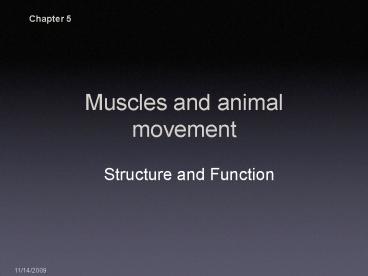Muscles and animal movement - PowerPoint PPT Presentation
1 / 43
Title:
Muscles and animal movement
Description:
Anchored at both ends. Microtubule-organization center (MTOC) ... Non-striated 'Involuntary' Cardiac muscle. Electrically coupled cells. Molluscan Catch muscle ... – PowerPoint PPT presentation
Number of Views:1637
Avg rating:3.0/5.0
Title: Muscles and animal movement
1
Muscles and animal movement
Chapter 5
- Structure and Function
2
Means of animal movement
- Effects of
- Inertia and momentum
- Viscosity of medium
- Microtubules
- Intracellular
- Cilia
- Flagellae
- Muscles
3
Microtubules
- Tubelike polymers of the protein tubulin
- Highly conserved
- Multiple isoforms
- Anchored at both ends
- Microtubule-organization center (MTOC) () near
the nucleus - Attached to integral proteins () in the plasma
membrane
4
Movement of pigment granules
5
Microtubule Assembly
Figure 5.4
6
Vesicle Traffic in a Neuron
7
Cilia and Flagella
Figure 5.8
8
Microtubules and Physiology
Table 5.1
9
Microfilament Structure and Growth (Actin)
10
Isolated actin filaments
11
Actin Networks
12
Actin and Myosin Function
Table 5.2
13
Muscle types
- Skeletal muscle
- Striated
- Voluntary
- Smooth muscle
- Non-striated
- Involuntary
- Cardiac muscle
- Electrically coupled cells
- Molluscan Catch muscle
- Insect flight muscle
14
Skeletal Muscle
- Many animals contain over 400 skeletal muscles
- 40-50 of total body weight
- Functions of skeletal muscle
- Locomotion and breathing
- Postural support
- Heat production
15
Structure of Skeletal MuscleConnective Tissue
Covering
- Epimysium
- Surrounds entire muscle
- Perimysium
- Surrounds bundles of muscle fibers (fascicles)
- Endomysium
- Surrounds individual muscle fibers
16
Structure of Skeletal MuscleMicrostructure
- Sarcolemma
- Muscle cell membrane
- Myofibrils
- Threadlike strands within muscle fibers
- Actin (thin filament)
- Troponin
- Tropomyosin
- Myosin (thick filament)
- Z-line
- a-actinin
17
Structure of Skeletal Muscle The Sarcomere
- Further divisions of myofibrils
- Z-line
- A-band
- I-band
- Within the sarcoplasm
- Sarcoplasmic reticulum
- Storage sites for calcium
- Transverse tubules
- Terminal cisternae
18
Thick and Thin Filaments
Figure 5.15
19
Myosin
Figure 5.12
20
(No Transcript)
21
(No Transcript)
22
(No Transcript)
23
Insect flight muscle
24
Three-Dimensional Structure of Sarcomere
Figure 5.18
25
Cross bridges
26
Muscular Contraction
- The sliding filament model
- Muscle shortening occurs due to the movement of
the actin filament over the myosin filament - Formation of cross-bridges between actin and
myosin filaments - Reduction in the distance between Z-lines of the
sarcomere
27
The sliding filament model
- Actin
- Myosin
- Actinin (z-disc)
28
(No Transcript)
29
Length/tension relationship for a vertebrate
sarcomere
30
Length/tension relationship for a whole muscle
31
Sliding Filament Model
Figure 5.13
32
Generation of force by myosin and actin
33
(No Transcript)
34
(No Transcript)
35
(No Transcript)
36
Troponin and Tropomyosin
Figure 5.21
37
(No Transcript)
38
Regulation of muscle contraction
39
Regulation of Contraction by Ca2
Figure 5.22
40
Calcium and ATP required for force
generation Force proportional to calcium
concentration
41
Calcium drives ATPase activity of myosin
42
Contraction occurs in presence of ATP and
calcium Relaxation occurs only in presence of ATP
43
- Summary of ionic events in muscle contraction































